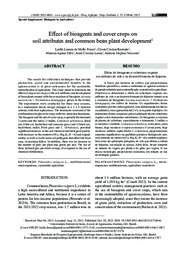Publicações
Effect of bioagents and cover crops on soil attributes and common bean plant development.
Autoria: FRASCA, L. L. de M.; REZENDE, C. C.; SILVA, M. A.; LANNA, A. C.; NASCENTE, A. S.
Resumo: The search for cultivation techniques that provide productive, social and environmental benefits to the agroecosystem is of great seriousness for the sustainable intensification of agriculture. This study aimed to determine the effect of crop cover crops on the soil attributes and development of bean plants treated with the consortium of bioagents Serratia marcencens + Trichodermakoningiopsis grown in the winter. The experiments were conducted for three crop seasons, in a randomized blocks design arranged in a 2 x 8 factorial scheme, with four replications. The treatments consisted of the combination of eight cover crops with two microbial treatments. The bioagents and the mix of cover crops, especially the treatment 2 (corn) and the mixes 3 (millet, Crotalariaochroleuca, black oat, white oat, buckwheat and coracana grass) and 5 (black oat, buckwheat, millet, Piatã grass and C. Ocholeuca), provided significant increases in the soil chemical and biological quality, with increases in the contents of Ca, Mg, K, H + Al and organic matter, as well as in the main soil pathogens that affect the bean crop, concerning fallow. In addition, there was an increase in the number of pods per plant and grains per pod. The use of these technologies provided savings, if compared to the use of chemical fertilization.
Ano de publicação: 2023
Tipo de publicação: Artigo de periódico
Unidade: Embrapa Arroz e Feijão

